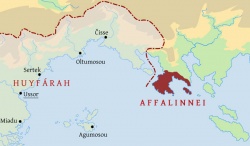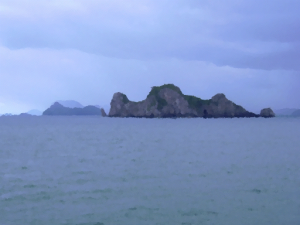Affalinnei
| Affalinnei Affalinnei | |

| |
| Capital | unknown |
| Major cities | unknown |
| Languages | Affanonic |
| Demonym | Affanons (pl.) |
| Government | hierarchy of clans evolving into monarchy |
| Formation | c. -200 YP |
| Collapse | unknown |
| Successor states | unknown |
| Credits | |
| Created by | Basilius |
| Edit me | |
The "kingdom" of Affalinnei (a native Affanonic compound, analyzable as 'eastern-leadership' or 'Affanonic-leadership') is a small state located on the Affalinnei Peninsula forming part of the southern coast of northeastern Peilaš, west of Lotoka. The dominant ethic group of the kingdom were the Affanons, speaking the Affanonic language of the Isles family.
History
The speakers of various Isles dialects were already present on the Affalinnei Peninsula as early as around -1000 YP, having migrated there from SW Tuysáfa via Sumarušuxi. Originally they occupied the coastal areas and did not dominate the hinterland inhabited mostly by Doroh-speaking tribes. However, as the increased importance of coastal trade transformed the settlements of Isles-speaking groups into seaports, their dialects served as the basis of the lingua franca spoken all over the country.
The kingdom of Affalinnei is first mentioned in historical sources dating from around -200 YP when the Affanons attempted at establishing some trading settlements or colonies in the coastal areas of Huyfárah. Later on the kingdom was involved in the efforts of the Fáralo rulers to exterminate piracy which was a serious impediment for coastal trade in the region. Some sources from early 1st millennium YP seem to mention the Affanons acting as vassals of Huyfárah, but the contexts do not provide sufficient detail.
State and Society
Although the earliest historical sources (mostly written in Huyfárah) usually call the state of the Affanons a "kingdom", this was most likely a misperception: the "king" (linnenon) of Affalinnei was indeed chosen from a specific kinship group, but originally the title was neither hereditary nor lifelong.
By the end of 1st millennium BP the society of the Affanons was organized as a hierarchy of clans (mintsokkwi, pl. mintsokkwijur) rather than individuals. The chief (mintsonon) of the leading clan (linnemintsoi) was also the supreme ruler (linnenon) of the country; however, a linnenon was elected via a set of complex procedures and could not retain his or her title after 50 years of age when the retired linnenon was automatically appointed the president of the clan's Assembly (mintsotifføf).
The hierarchical relations between clans, although typically centuries-old already by -200 YP, were not absolutely rigid either; thus, the leading clan of Affalinnei changed no less than four times between -200 YP and 400 YP. Besides, clans could split and sometimes merge. The country was divided into clan possessions (mintswil, pl. mintswilhur), but in big cities the members of different clans were mixed.
It is interesting to note that ethnic identity played little part in the hierarchy of clans: some influential clans were known to be of a non-Affanonic origin, and in everyday life their members spoke local Peninsular dialects (related to Lotoka) or tribal languages of Isthmus origin (akin to Doroh). Besides, the dialects of a few groups usually identified with the Affanons were in fact separate Isles languages hardly mutually intelligible with Affanonic.
By ca. 200 YP profound transformations of the clan structure had started. Membership in the linnemintsoi, as well as in a few other prestigeous clans, was increasingly often granted for individual merits; double and multiple clan membership becomes common, As a result, the linnemintsoi differentiated, and from 230 YP on the issues of power transition were decided on by so-called "Narrow Assembly" (Mimati Tifføf) composed of closest relatives and most trusted attendants of the linnenon; the default candidate linnenon was invariably the retiring linnenon’s eldest son.
Religion
The Affanons worshiped a whole pantheon of gods headed by the supreme celestial deity, Tejenry. Since the Sun and the Moon were considered the Eyes of Tejenry, special importance was attributed to the times when both are seen simultaneously, i.e. when Tejenry watches the mortals with both of His eyes.
Names
| Language | Name | Pronunciation | Source |
|---|---|---|---|
| Affanonic | Affalinnei (esp. referring to the state); Affanamil (esp. when speaking of the territory) |
[af.fa.ˈlin.nei], [af.ˈfa.na.mil] | native compounds, lit. "eastern-leadership", "eastern-person-country" |
| Buruya Nzaysa | Falíni | [faˈli.ni] | ← Aff. Affalinnei (borrowed) |
| Naidda | Avalini | [ˈa.və.li.ni] | ← Aff. Affalinnei (borrowed) |
| Woltu Falla | Affalinne | [af.faˈlin.ne] | ← Aff. Affalinnei (borrowed) |
| Cəssın | Ävlinni | [ˈæ.vlin.ni] | ← Aff. Affalinnei (borrowed) |
See also
